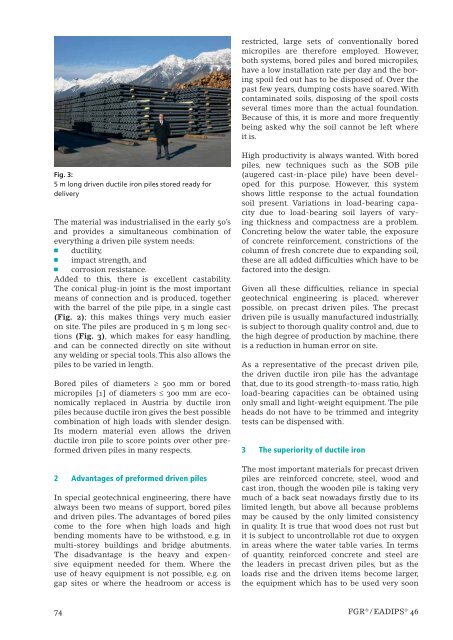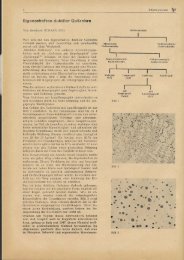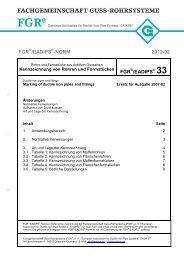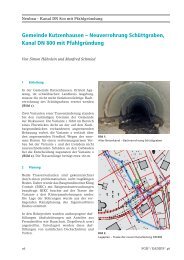Download PDF file
Download PDF file
Download PDF file
- TAGS
- download
- 81.169.135.155
You also want an ePaper? Increase the reach of your titles
YUMPU automatically turns print PDFs into web optimized ePapers that Google loves.
Fig. 3:<br />
5 m long driven ductile iron piles stored ready for<br />
delivery<br />
The material was industrialised in the early 50’s<br />
and provides a simultaneous combination of<br />
everything a driven pile system needs:<br />
■ ductility,<br />
■ impact strength, and<br />
■ corrosion resistance.<br />
Added to this, there is excellent castability.<br />
The conical plug-in joint is the most important<br />
means of connection and is produced, together<br />
with the barrel of the pile pipe, in a single cast<br />
(Fig. 2); this makes things very much easier<br />
on site. The piles are produced in 5 m long sections<br />
(Fig. 3), which makes for easy handling,<br />
and can be connected directly on site without<br />
any welding or special tools. This also allows the<br />
piles to be varied in length.<br />
Bored piles of diameters � 500 mm or bored<br />
micropiles [1] of diameters � 300 mm are economically<br />
replaced in Austria by ductile iron<br />
piles because ductile iron gives the best possible<br />
combination of high loads with slender design.<br />
Its modern material even allows the driven<br />
ductile iron pile to score points over other preformed<br />
driven piles in many respects.<br />
2 Advantages of preformed driven piles<br />
In special geotechnical engineering, there have<br />
always been two means of support, bored piles<br />
and driven piles. The advantages of bored piles<br />
come to the fore when high loads and high<br />
bending moments have to be withstood, e. g. in<br />
multi-storey buildings and bridge abutments.<br />
The disadvantage is the heavy and expensive<br />
equipment needed for them. Where the<br />
use of heavy equipment is not possible, e.g. on<br />
gap sites or where the headroom or access is<br />
74<br />
restricted, large sets of conventionally bored<br />
micropiles are therefore employed. However,<br />
both systems, bored piles and bored micropiles,<br />
have a low installation rate per day and the boring<br />
spoil fed out has to be disposed of. Over the<br />
past few years, dumping costs have soared. With<br />
contaminated soils, disposing of the spoil costs<br />
several times more than the actual foundation.<br />
Because of this, it is more and more frequently<br />
being asked why the soil cannot be left where<br />
it is.<br />
High productivity is always wanted. With bored<br />
piles, new techniques such as the SOB pile<br />
(augered cast-in-place pile) have been developed<br />
for this purpose. However, this system<br />
shows little response to the actual foundation<br />
soil present. Variations in load-bearing capacity<br />
due to load-bearing soil layers of varying<br />
thickness and compactness are a problem.<br />
Concreting below the water table, the exposure<br />
of concrete reinforcement, constrictions of the<br />
column of fresh concrete due to expanding soil,<br />
these are all added difficulties which have to be<br />
factored into the design.<br />
Given all these difficulties, reliance in special<br />
geotechnical engineering is placed, wherever<br />
possible, on precast driven piles. The precast<br />
driven pile is usually manufactured industrially,<br />
is subject to thorough quality control and, due to<br />
the high degree of production by machine, there<br />
is a reduction in human error on site.<br />
As a representative of the precast driven pile,<br />
the driven ductile iron pile has the advantage<br />
that, due to its good strength-to-mass ratio, high<br />
load-bearing capacities can be obtained using<br />
only small and light-weight equipment. The pile<br />
heads do not have to be trimmed and integrity<br />
tests can be dispensed with.<br />
3 The superiority of ductile iron<br />
The most important materials for precast driven<br />
piles are reinforced concrete, steel, wood and<br />
cast iron, though the wooden pile is taking very<br />
much of a back seat nowadays firstly due to its<br />
limited length, but above all because problems<br />
may be caused by the only limited consistency<br />
in quality. It is true that wood does not rust but<br />
it is subject to uncontrollable rot due to oxygen<br />
in areas where the water table varies. In terms<br />
of quantity, reinforced concrete and steel are<br />
the leaders in precast driven piles, but as the<br />
loads rise and the driven items become larger,<br />
the equipment which has to be used very soon<br />
FGR® / EADIPS® 46
















